Posts Tagged ‘Intellectual property’
Is Contract Manufacturing in China Still Viable?

In today’s globalized world, businesses are constantly seeking cost-effective and efficient manufacturing solutions. Contract manufacturing in China has been a go-to option for many companies around the world due to its potential benefits.
However, with the changing economic landscape and geopolitical considerations, is contract manufacturing in China still a viable choice? In this article, we will delve into the advantages and disadvantages of outsourcing manufacturing to China and assess its current viability for businesses worldwide.
Understanding Contract Manufacturing in China
Before diving into the pros and cons, let’s define what contract manufacturing means. Contract manufacturing is the process of outsourcing production to a third-party manufacturer. Companies often opt for this approach to reduce costs, access specialized expertise, and focus on core competencies.
In the context of China, it involves collaborating with Chinese manufacturers to produce goods at a larger scale.
The Pros of Contract Manufacturing in China
Cost-Effectiveness and Labor Availability
One of the primary reasons businesses turn to China for contract manufacturing is its cost-effectiveness. China’s relatively lower labor costs allow companies to manufacture products at a competitive price. Additionally, the country boasts a vast pool of skilled and unskilled labor, offering ample workforce availability for large-scale production.
Technological Advancements and Expertise
Over the years, China has made significant strides in technological advancements. Partnering with Chinese manufacturers grants access to cutting-edge technology and specialized expertise, enabling businesses to produce high-quality products with the latest features.
Supply Chain Efficiency and Infrastructure
China’s well-established supply chain infrastructure plays a crucial role in efficient production and timely delivery of goods. From raw material sourcing to shipping logistics, the country’s well-oiled supply chain ensures a smooth manufacturing process.
Cultural and Language Considerations
China’s unique cultural perspective and language skills can prove advantageous for businesses with a global customer base. Manufacturers in China can better understand and cater to the preferences of diverse markets, ensuring products align with the needs of international consumers.
The Cons of Contract Manufacturing in China
Geopolitical and Trade Uncertainties
The geopolitical landscape can impact contract manufacturing in China. Trade tensions and policy changes between China and other countries may lead to uncertainties, affecting the smooth flow of goods and causing potential disruptions.
Quality Control Challenges
Maintaining consistent product quality can be challenging when manufacturing overseas. Businesses must invest in stringent quality control measures to ensure the products meet international standards and satisfy customer expectations.
Intellectual Property Risks
Protecting intellectual property rights can be a concern when outsourcing to China. Companies must take appropriate legal measures and work closely with manufacturers to safeguard their innovations and prevent counterfeiting.
Communication and Time Zone Differences
Effective communication is essential for successful contract manufacturing. Language barriers and time zone differences may lead to misinterpretations or delays in critical decision-making processes.
Environmental and Ethical Concerns
Outsourcing to countries with lax environmental regulations can raise ethical dilemmas. Businesses must be mindful of their environmental footprint and the ethical implications of their manufacturing choices.
Is Contract Manufacturing in China Still Viable?
With the pros and cons considered, the question remains: is contract manufacturing in China still a viable option for businesses? The answer varies depending on individual business needs, market conditions, and the ability to navigate the challenges associated with outsourcing to China.
Adapting to the Changing Landscape
While China continues to be a major player in contract manufacturing, businesses should adapt their strategies to account for evolving geopolitical and economic landscapes. Diversifying manufacturing locations and exploring other emerging markets can mitigate risks and enhance overall resilience.
Diversifying Manufacturing Strategies
Rather than relying solely on a single manufacturing location, businesses can consider a hybrid approach that involves diversifying their manufacturing strategies. Combining in-house production with strategic partnerships in different countries can offer more flexibility and reduce dependency on a single region.
Contract manufacturing in China still holds potential benefits, but it also comes with challenges, including geopolitical uncertainties, quality control issues, and ethical concerns. Businesses must carefully evaluate their unique needs and risk tolerance before deciding whether to opt for contract manufacturing in China or adopt a diversified manufacturing strategy. If you choose to work with an experienced manufacturer, you can be rest-assured. One like Shield Works is your perfect choice with their adequate experience and vast network of suppliers. Contact us now!
What You Need to Know About Product Design in China
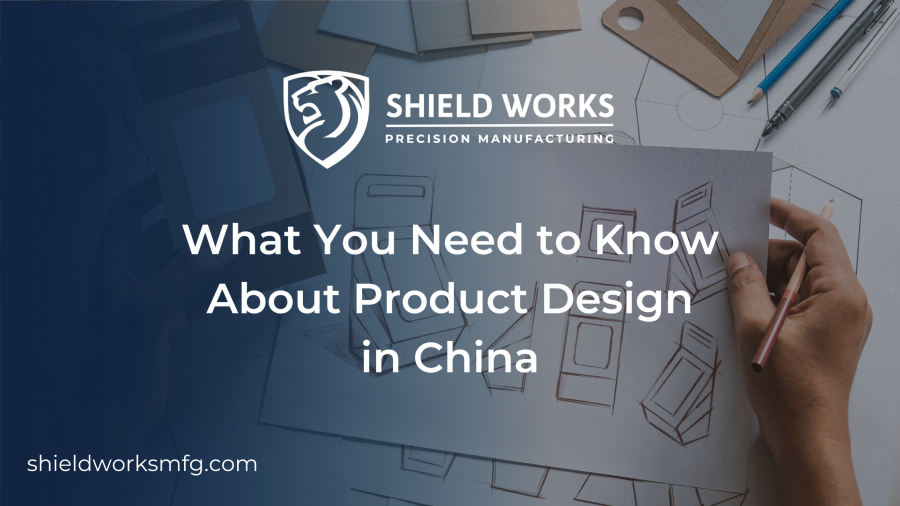
When it comes to product design, China has emerged as a global leader, offering innovative solutions and unparalleled manufacturing capabilities. Whether you are an entrepreneur looking to launch a new product or a business aiming to expand into new markets, understanding the intricacies of product design in China is crucial.
In this article, we will explore the essential aspects of product design in China, shedding light on its benefits, challenges, and market trends. So, let’s dive in and unlock the potential that Chinese product design holds for your business.
The Importance of Product Design in China
Product design plays a pivotal role in the success of any business, and China has become a hub for innovative design solutions. With its vast pool of talented designers and cutting-edge technology, China offers businesses a competitive edge in the global market.
Effective product design enables companies to differentiate themselves, create appealing products, and meet the ever-evolving needs of consumers.
Embracing Innovation and Efficiency
China’s product design landscape is characterized by its commitment to innovation and efficiency. Chinese designers leverage advanced technologies and embrace novel ideas to create groundbreaking products.
By collaborating with Chinese design firms, businesses gain access to fresh perspectives, out-of-the-box thinking, and streamlined design processes, leading to faster time-to-market and enhanced competitiveness.
Understanding the Chinese Consumer
To succeed in China’s vast and diverse market, understanding the preferences and expectations of the Chinese consumer is vital. Chinese consumers have distinct tastes, influenced by cultural factors, social trends, and economic conditions.
By incorporating local insights into product design, businesses can tailor their offerings to align with Chinese consumers’ desires, increasing the chances of market success.
Navigating Intellectual Property Rights
Protecting intellectual property (IP) is a concern for businesses operating in any country, and China is no exception. While China has made significant progress in strengthening IP laws and enforcement, challenges still exist.
Engaging with experienced legal counsel and taking proactive measures can help safeguard your designs and inventions throughout the product design process in China.
Collaborating with Local Design Agencies
Collaborating with local design agencies can provide invaluable advantages when entering the Chinese market. These agencies possess in-depth knowledge of the local industry landscape, consumer behavior, and design trends.
By leveraging their expertise and network, businesses can create products that resonate with the Chinese market, improving market penetration and brand perception.
Cultural Sensitivity and Localization
Culture plays a crucial role in product design, and China’s rich cultural heritage demands careful consideration. Adapting your product to reflect cultural preferences, symbolism, and traditions can significantly enhance its appeal to Chinese consumers.
Localization goes beyond language translation and involves tailoring the design elements, packaging, and marketing strategies to align with the cultural sensibilities of the target audience.
Streamlining the Manufacturing Process
China’s reputation as the “world’s factory” stems from its efficient manufacturing capabilities. When embarking on product design in China, it is essential to collaborate closely with manufacturers.
By involving them early in the design process, businesses can benefit from their expertise and optimize the design for manufacturability, ensuring cost-effectiveness and streamlined production.
Overcoming Language and Communication Barriers
Language and communication barriers can pose challenges when working with Chinese partners. Effective communication is vital to ensure clarity, avoid misunderstandings, and maintain productive relationships.
Employing translators, hiring bilingual staff, or partnering with experienced local professionals can help bridge the language gap and foster effective collaboration throughout the product design journey.
Adapting to Changing Market Trends
The Chinese market is dynamic and constantly evolving. Staying abreast of the latest market trends is crucial for successful product design in China.
By analyzing consumer behavior, market research, and emerging technologies, businesses can identify opportunities for innovation, anticipate market demands, and create products that cater to the ever-changing preferences of Chinese consumers.
Ensuring Quality Control and Compliance
Maintaining quality standards and compliance is essential to build trust and protect your brand reputation.
Working closely with manufacturing partners to establish robust quality control processes, conducting regular inspections, and adhering to relevant regulations and certifications are vital steps to ensure that your products meet the required standards and deliver customer satisfaction.
Product design in China offers businesses a gateway to innovation, efficiency, and market success. As the global business landscape continues to evolve, product design in China remains a vital strategy for businesses looking to thrive in a competitive world. You can also choose to work with a manufacturer like Shield Works, one with their own in-house international team of industrial designers and engineers to craft your vision into a concrete reality. Contact us now!
How Contract Assembly Boosts Productivity
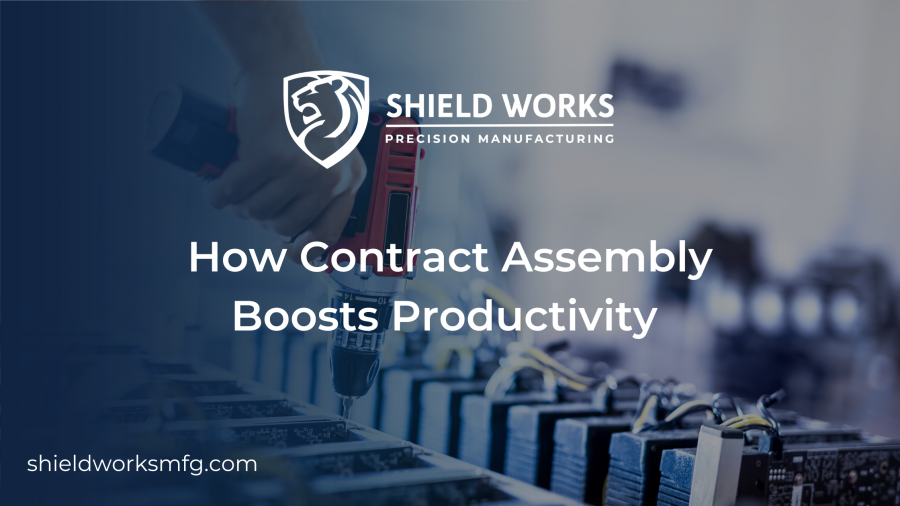
When it comes to product design, China has emerged as a global leader, offering innovative solutions and unparalleled manufacturing capabilities. Whether you are an entrepreneur looking to launch a new product or a business aiming to expand into new markets, understanding the intricacies of product design in China is crucial.
In this article, we will explore the essential aspects of product design in China, shedding light on its benefits, challenges, and market trends. So, let’s dive in and unlock the potential that Chinese product design holds for your business.
The Importance of Product Design in China
Product design plays a pivotal role in the success of any business, and China has become a hub for innovative design solutions. With its vast pool of talented designers and cutting-edge technology, China offers businesses a competitive edge in the global market.
Effective product design enables companies to differentiate themselves, create appealing products, and meet the ever-evolving needs of consumers.
Embracing Innovation and Efficiency
China’s product design landscape is characterized by its commitment to innovation and efficiency. Chinese designers leverage advanced technologies and embrace novel ideas to create groundbreaking products.
By collaborating with Chinese design firms, businesses gain access to fresh perspectives, out-of-the-box thinking, and streamlined design processes, leading to faster time-to-market and enhanced competitiveness.
Understanding the Chinese Consumer
To succeed in China’s vast and diverse market, understanding the preferences and expectations of the Chinese consumer is vital. Chinese consumers have distinct tastes, influenced by cultural factors, social trends, and economic conditions.
By incorporating local insights into product design, businesses can tailor their offerings to align with Chinese consumers’ desires, increasing the chances of market success.
Navigating Intellectual Property Rights
Protecting intellectual property (IP) is a concern for businesses operating in any country, and China is no exception. While China has made significant progress in strengthening IP laws and enforcement, challenges still exist.
Engaging with experienced legal counsel and taking proactive measures can help safeguard your designs and inventions throughout the product design process in China.
Collaborating with Local Design Agencies
Collaborating with local design agencies can provide invaluable advantages when entering the Chinese market. These agencies possess in-depth knowledge of the local industry landscape, consumer behavior, and design trends.
By leveraging their expertise and network, businesses can create products that resonate with the Chinese market, improving market penetration and brand perception.
Cultural Sensitivity and Localization
Culture plays a crucial role in product design, and China’s rich cultural heritage demands careful consideration. Adapting your product to reflect cultural preferences, symbolism, and traditions can significantly enhance its appeal to Chinese consumers.
Localization goes beyond language translation and involves tailoring the design elements, packaging, and marketing strategies to align with the cultural sensibilities of the target audience.
Streamlining the Manufacturing Process
China’s reputation as the “world’s factory” stems from its efficient manufacturing capabilities. When embarking on product design in China, it is essential to collaborate closely with manufacturers.
By involving them early in the design process, businesses can benefit from their expertise and optimize the design for manufacturability, ensuring cost-effectiveness and streamlined production.
Overcoming Language and Communication Barriers
Language and communication barriers can pose challenges when working with Chinese partners. Effective communication is vital to ensure clarity, avoid misunderstandings, and maintain productive relationships.
Employing translators, hiring bilingual staff, or partnering with experienced local professionals can help bridge the language gap and foster effective collaboration throughout the product design journey.
Adapting to Changing Market Trends
The Chinese market is dynamic and constantly evolving. Staying abreast of the latest market trends is crucial for successful product design in China.
By analyzing consumer behavior, market research, and emerging technologies, businesses can identify opportunities for innovation, anticipate market demands, and create products that cater to the ever-changing preferences of Chinese consumers.
Ensuring Quality Control and Compliance
Maintaining quality standards and compliance is essential to build trust and protect your brand reputation.
Working closely with manufacturing partners to establish robust quality control processes, conducting regular inspections, and adhering to relevant regulations and certifications are vital steps to ensure that your products meet the required standards and deliver customer satisfaction.
Product design in China offers businesses a gateway to innovation, efficiency, and market success. As the global business landscape continues to evolve, product design in China remains a vital strategy for businesses looking to thrive in a competitive world. You can also choose to work with a manufacturer like Shield Works, one with their own in-house international team of industrial designers and engineers to craft your vision into a concrete reality. Contact us now!
5 Tips on How to Source OEM Products
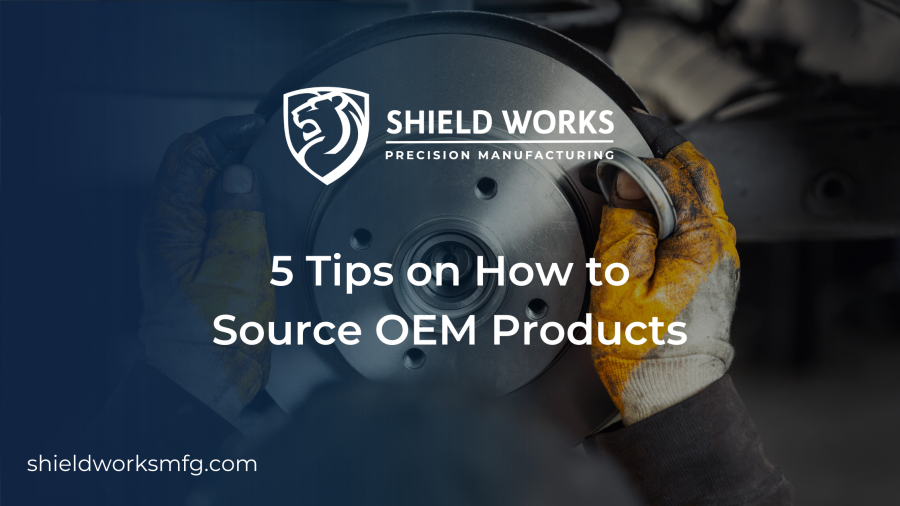
Sourcing OEM products can be a daunting task, but it doesn’t have to be. With the right knowledge and tactics, it can be an easier process. Here are 5 tips on how to source OEM products quickly and efficiently, so you can get the products you need without any hassle.
1) Understand Your Needs
Before embarking on the journey to source OEM products, it’s crucial to take a step back and fully understand your needs. This involves analyzing your business operations, assessing market demand and trends, and identifying the type of products you require. A clear understanding of your needs sets the foundation for a successful sourcing strategy.
First, analyze your business operations and identify any areas that need improvement or expansion. Are you experiencing challenges in meeting customer demand for a particular product? Or are you looking to introduce new products to your line to cater to a growing market segment? Answering these questions will help you determine the type of OEM products you require.
Next, assess market demand and trends to ensure that the products you source are in high demand. This involves researching industry reports, attending trade shows, and keeping up with current news and trends in your field. Understanding market demand will give you a competitive advantage and increase the likelihood of your products being successful.
Finally, identify the specific features and requirements you need for your OEM products. This includes product specifications, quality standards, and production volumes. Communicating these requirements to potential suppliers early on will ensure that you source products that meet your needs and expectations.
Overall, taking the time to fully understand your needs before sourcing OEM products will help you make informed decisions and select the right suppliers. This will save you time, money, and potential headaches down the line.
2) Research and Identify Potential Suppliers
Once you have identified your product requirements and specifications, it’s time to research and identify potential suppliers who can fulfill those needs. There are a few key things to keep in mind during this stage of the sourcing process.
First, you should cast a wide net and explore multiple sourcing options. This may include online marketplaces, trade shows, industry events, and personal referrals from business associates. Don’t limit yourself to just one channel, as you may miss out on some excellent potential suppliers.
Next, you should conduct thorough research on each potential supplier. This includes reviewing their company background, product portfolio, quality control processes, and customer feedback. You should also assess their capacity and production capabilities, as well as their delivery and lead times. This information will help you determine whether the supplier is a good match for your needs.
When researching suppliers, it’s also important to consider their location and proximity to your business. Suppliers that are closer may offer shorter delivery times and lower transportation costs. However, you should not let location be the sole determining factor, as quality and price are equally important considerations.
Finally, it’s important to contact each potential supplier and ask for detailed information about their products, services, and pricing. You should also ask for samples or product demos to help you evaluate the quality of their offerings. This communication will also allow you to assess the supplier’s responsiveness, professionalism, and willingness to work with you.
By conducting thorough research and identifying potential suppliers, you will be able to make informed decisions and select the best supplier for your business needs. Remember to keep an open mind and explore multiple options, as this will increase your chances of finding a reliable and trustworthy supplier.
3) Evaluate Supplier Capabilities
Once you have identified potential suppliers for your OEM products, the next crucial step is to evaluate their capabilities. This evaluation process is crucial to ensure that you choose the right supplier who can meet your requirements and deliver high-quality products consistently.
One of the first aspects to consider when evaluating supplier capabilities is their experience and track record in producing OEM products. You should assess their expertise in your specific industry and the types of products they have manufactured in the past. This information will give you a good indication of their ability to handle your project effectively.
Next, you should examine the supplier’s production facilities and technology. A well-equipped facility with advanced machinery and technology can greatly impact the quality and efficiency of the production process. Additionally, make sure to inquire about the supplier’s production capacity to ensure they can meet your order quantities and deadlines.
Quality control is another vital aspect to consider when evaluating supplier capabilities. Inquire about the supplier’s quality control processes and certifications. A reliable supplier should have a robust quality control system in place to ensure that all products meet your specifications and standards.
Communication is key when evaluating supplier capabilities. Pay attention to how responsive and transparent the supplier is during the evaluation process. A good supplier should be willing to provide detailed information about their capabilities, production process, and any other relevant information you may require.
Furthermore, it is essential to assess the supplier’s financial stability and reliability. Request references or testimonials from other clients to get an idea of their reputation in the industry. You want to work with a supplier that is financially secure and can deliver your orders on time without any issues.
4) Communicate Your Requirements Clearly
One of the most crucial steps in sourcing OEM products is effectively communicating your requirements to potential suppliers. Clear communication is essential for ensuring that the supplier understands your expectations and can deliver the desired products.
To communicate your requirements clearly, start by preparing a detailed and concise document outlining your product specifications, quality standards, and any other specific requirements. This document will serve as a reference point during discussions with suppliers and will help avoid any misunderstandings later on.
When discussing your requirements with suppliers, make sure to ask clarifying questions and encourage them to ask questions as well. This will help ensure that both parties are on the same page and have a thorough understanding of the project.
It’s also important to clearly communicate your timeline and any constraints that may impact the production or delivery of the products. This will enable the supplier to plan their production accordingly and avoid any potential delays.
During these discussions, it’s beneficial to establish open lines of communication and maintain regular contact with the supplier. This will allow for ongoing updates and discussions, which can help address any potential issues or changes in requirements that may arise throughout the sourcing process.
In addition to verbal communication, written communication is also crucial. Ensure that all important details and agreements are documented in writing, such as pricing, delivery terms, and quality control processes. This will provide a clear reference for both parties and help avoid any disputes or misunderstandings in the future.
Remember that effective communication is a two-way street. Actively listen to the supplier’s suggestions and feedback, and be open to compromise if necessary. A collaborative approach can lead to better outcomes and a stronger working relationship with your supplier.
By clearly communicating your requirements and maintaining open lines of communication, you can significantly improve the efficiency of your sourcing process and increase the likelihood of successful outcomes with OEM products.
5) Negotiate Contracts and Agreements
Once you have identified potential suppliers and evaluated their capabilities, the next step in sourcing OEM products is to negotiate contracts and agreements. This is a crucial step that can have a significant impact on the success of your business partnership.
When negotiating contracts and agreements with suppliers, it is important to clearly outline your expectations, requirements, and terms. Be transparent about your budget, delivery timelines, quality standards, and any other specific needs. This will ensure that both parties are on the same page and can work towards a mutually beneficial agreement.
During negotiations, be prepared to discuss pricing, payment terms, order quantities, and any additional services or support you may require. It is important to strike a balance between securing the best possible price and ensuring the supplier’s profitability. Negotiate for reasonable lead times, product warranties, and a system for addressing any potential issues or disputes that may arise.
To have a successful negotiation, maintain open and honest communication with the supplier. Listen to their concerns and be willing to compromise when necessary. Establishing a strong and respectful relationship with your supplier is crucial for long-term success.
Once the negotiation is complete, ensure that all agreed-upon terms are documented in a formal contract. This contract should include details such as pricing, payment terms, delivery schedules, quality requirements, and any other relevant information. Review the contract carefully before signing to avoid any misunderstandings or surprises later on.
By following these tips and negotiating contracts and agreements effectively, you can secure the best possible terms and ensure a successful partnership with your OEM supplier.
In conclusion, sourcing OEM products can be a complex process, but following these tips can help you streamline the process and find the best supplier for your needs. Choosing the right OEM manufacturer can make all the difference in the quality and cost-effectiveness of your products. At Shield Works, we pride ourselves on being the ideal partner for businesses looking to source OEM products. With our in-house assembly facility and extensive network of suppliers in Asia, we can ensure that you get the best products at competitive prices. Contact us today to learn more about how we can help you with your OEM product sourcing needs.
How Automation Can Help Streamline Your Product Assembly Process?
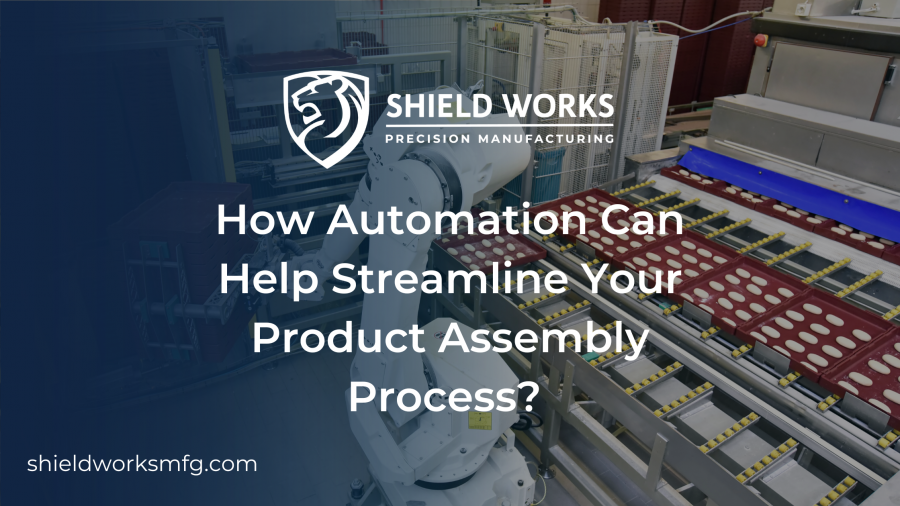
Automation has become an integral part of numerous industries, revolutionizing processes and enhancing productivity. In the realm of product assembly, automation holds immense potential for streamlining operations and improving overall efficiency.
In this article, we will explore how automation can help optimize your product assembly process, allowing you to deliver high-quality products while minimizing costs and time.
Understanding Automation in Product Assembly
Automation in product assembly refers to the use of technology and machinery to perform repetitive tasks that were traditionally carried out by humans.
These tasks can include picking and placing components, tightening screws, performing quality checks, and packaging finished products.
By automating these processes, businesses can eliminate human error, increase production speed, and improve overall accuracy.
Benefits of Automation in Streamlining Product Assembly
- Enhanced Efficiency: Automation significantly improves the speed and accuracy of product assembly, resulting in increased output and reduced production time.
- Reduced Costs: By automating repetitive tasks, businesses can minimize labor costs, as well as reduce errors and rework expenses.
- Improved Quality Control: Automation ensures consistent quality control throughout the assembly process, reducing defects and enhancing customer satisfaction.
- Optimized Resource Utilization: Automated systems can utilize resources more efficiently, allowing businesses to allocate their workforce to more complex and strategic tasks.
- Worker Safety: By automating hazardous or physically demanding tasks, businesses can prioritize worker safety and minimize the risk of accidents or injuries.
Implementing Automation: Best Practices
When integrating automation into your product assembly process, consider the following best practices:
- Thorough Process Analysis: Identify the tasks that can be automated and evaluate their feasibility and potential impact on the overall process.
- Investment Planning: Determine the budget and timeline required for implementing automation, including equipment costs, training, and system integration.
- Collaboration with Experts: Consult with automation specialists and suppliers who can provide valuable insights and recommend suitable solutions for your specific needs.
- Gradual Implementation: Implement automation gradually, starting with smaller-scale projects to test and refine the process before scaling up.
- Training and Workforce Adaptation: Provide proper training to your workforce to ensure smooth adoption of automation technologies and address any concerns or resistance.
- Continuous Monitoring and Improvement: Regularly monitor the automated processes, gather data, and analyze performance to identify areas for further optimization.
Overcoming Challenges in Automating Product Assembly
While automation brings numerous benefits, it also presents challenges that businesses need to address:
- Initial Investment: The upfront cost of automation can be substantial, requiring careful financial planning and evaluation of long-term returns on investment.
- System Integration: Integrating automation systems with existing infrastructure and software can be complex and may require specialized expertise.
- Workforce Adaptation: Some employees may be resistant to change or fear job displacement. Providing proper training and transparent communication is crucial to address these concerns.
- Maintenance and Upkeep: Automated systems require regular maintenance and occasional upgrades, which should be factored into the overall cost and operational planning.
- Flexibility and Scalability: Ensuring that the automated systems are flexible and adaptable to future changes in product design or assembly requirements is essential.
Future Trends in Automation for Product Assembly
The field of automation is constantly evolving, and several trends are shaping the future of product assembly:
- Collaborative Robots: Collaborative robots, also known as cobots, are designed to work alongside humans, enabling safe and efficient collaboration in assembly tasks.
- Artificial Intelligence: AI-powered systems can analyze data, make decisions, and optimize assembly processes in real-time, leading to further improvements in efficiency and quality.
- Internet of Things (IoT) Integration: By connecting assembly line components and machines through IoT, businesses can gather real-time data for predictive maintenance and process optimization.
- Advanced Vision Systems: Vision systems equipped with advanced cameras and sensors can enhance quality control by detecting defects and abnormalities with high accuracy.
- Automation as a Service: Cloud-based automation platforms offer scalable and flexible solutions, allowing businesses to implement automation without significant upfront investments.
Automation is a powerful tool that can revolutionize the product assembly process, enabling businesses to streamline operations, improve efficiency, and deliver high-quality products to their customers.
To stay competitive in the rapidly evolving market, it is crucial for businesses to explore the potential of automation and implement it strategically in their product assembly workflows. Or you can choose to work with a manufacturer that has highly automated their production process, such as Shield Works, one with their own in-house facility and 18 years of industry experience, always looking to innovate their manufacturing expertise. Contact us today!
Key Elements of Manufacturing Contracts You Should Know

In the world of manufacturing, contracts play a crucial role in establishing and regulating business relationships between manufacturers and their clients. These legal agreements outline the terms and conditions under which goods are produced, ensuring that both parties are protected and their rights and obligations are clearly defined.
This article will delve into the key elements of manufacturing contracts that every business owner should be familiar with. By understanding these essential components, you can enter into contracts confidently, safeguard your interests, and foster successful partnerships.
Parties Involved
The first fundamental element of a manufacturing contract is identifying the parties involved. This section should clearly state the names and contact details of both the manufacturer and the client.
It’s essential to accurately represent the legal entities or individuals entering into the agreement to avoid any confusion or disputes in the future. Including a brief description of each party’s business activities can also provide context and establish the nature of the relationship.
Scope of Work
The scope of work section defines the specific products or services to be manufactured by the supplier. It should include detailed descriptions, specifications, and any relevant technical documentation.
This section serves as a blueprint for the manufacturing process, ensuring that both parties are on the same page regarding the expected deliverables. Clear and concise language is essential in this section to minimize the risk of misinterpretation or ambiguity.
Pricing and Payment Terms
One of the most critical aspects of any manufacturing contract is the pricing and payment terms. This section should outline the agreed-upon pricing structure, including the cost per unit, any applicable discounts, and payment milestones.
Specify the payment method, whether it’s a lump sum, installment, or a combination of both. Additionally, include details about late payment penalties, currency, and any additional charges such as taxes or shipping fees. By clearly defining the financial aspects, this section ensures transparency and minimizes financial disputes.
Quality Assurance and Inspection
To maintain product quality and ensure customer satisfaction, a manufacturing contract should include provisions for quality assurance and inspection. Clearly define the quality standards, testing procedures, and acceptance criteria that the manufactured goods must meet.
This section should also outline the rights and responsibilities of both parties concerning inspection and quality control. By setting these parameters, you can mitigate the risk of receiving substandard products and establish a process for resolving quality-related issues.
Intellectual Property Rights
Intellectual property (IP) rights are of paramount importance in manufacturing contracts. This section should address ownership and protection of intellectual property associated with the manufacturing process, such as patents, trademarks, copyrights, and trade secrets.
Specify who will retain ownership of any new inventions or improvements made during the manufacturing process. Additionally, outline confidentiality obligations to safeguard sensitive information shared between the parties. Clear guidelines on intellectual property protect your innovations and prevent unauthorized use or disclosure.
Term and Termination
The term and termination section establishes the duration of the manufacturing contract and the circumstances under which either party can terminate the agreement. Clearly state the contract’s start date and end date, as well as any provisions for renewal or extension.
Include details on the notice period required for termination and any consequences or penalties associated with early termination. A well-defined termination clause ensures that both parties have a clear understanding of their rights and obligations throughout the contract’s duration.
Dispute Resolution
In the event of a dispute or disagreement, having a clearly defined dispute resolution process can help resolve issues efficiently and avoid costly litigation. This section should outline the preferred method of dispute resolution, such as negotiation, mediation, or arbitration. Specify the jurisdiction and venue for any legal proceedings.
It’s crucial to include a provision for resolving disputes amicably before resorting to legal action. A well-crafted dispute resolution clause promotes fair and timely resolution, preserving the business relationship between the manufacturer and the client.
Manufacturing contracts are vital tools for establishing successful business relationships in the manufacturing industry. By understanding the key elements of these contracts, you can ensure that your manufacturing agreements are comprehensive, fair, and beneficial to all parties involved.
Working with a manufacturer like Shield Works will make the process much easier. Our western background and 18 years of experience will provide a solid foundation for your manufacturing endeavors, minimize risks, and promote long-term success. Call us today!
Tips to Make Your Contract Manufacturing Process in China Easier
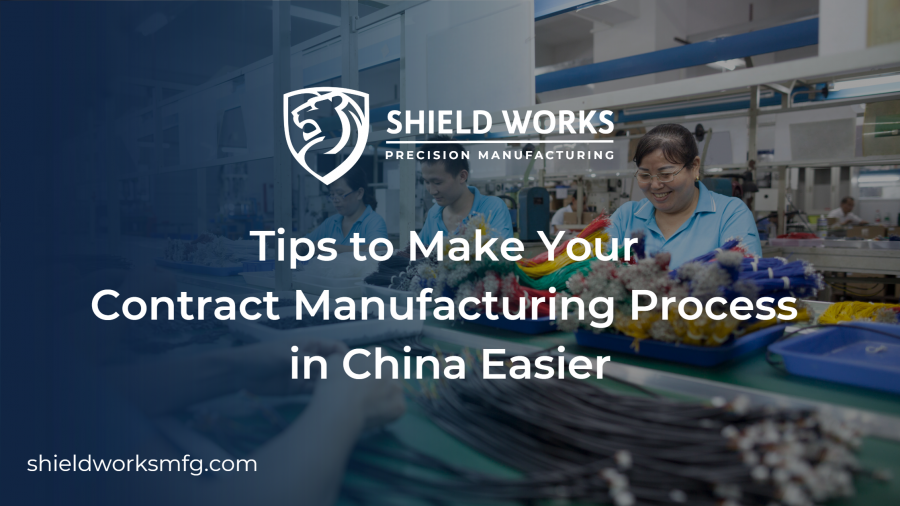
Contract manufacturing in China has become increasingly popular for businesses looking to reduce costs and take advantage of the country’s manufacturing capabilities.
However, navigating the contract manufacturing process in China can be complex and challenging, especially for those who are unfamiliar with the local business practices and cultural nuances.
In this article, we will provide you with valuable tips to make your contract manufacturing process in China easier, enabling you to optimize your operations and achieve successful outcomes.
Understanding the Chinese Manufacturing Landscape
Before diving into the tips, it’s important to have a clear understanding of the Chinese manufacturing landscape. China is renowned for its vast manufacturing infrastructure, which offers a wide range of capabilities and cost advantages.
From electronics to textiles, China has a diverse array of industries capable of meeting various production requirements. Additionally, the country boasts a skilled workforce and a strong supply chain network, further enhancing its appeal as a contract manufacturing destination.
Conduct Thorough Supplier Research
When engaging in contract manufacturing in China, conducting thorough supplier research is crucial. Look for reputable manufacturers with a proven track record in your industry. Request references and samples of their previous work to assess the quality of their products.
Make sure to verify their certifications, licenses, and compliance with international standards. Performing due diligence on potential suppliers will help you identify reliable partners and minimize the risk of working with subpar manufacturers.
Establish Clear Communication Channels
Effective communication is key to a successful contract manufacturing process. Establish clear and open lines of communication with your Chinese manufacturing partner. Overcome language barriers by hiring translators or working with bilingual staff.
Utilize video conferencing tools and project management software to facilitate real-time communication. Regularly scheduled meetings and written documentation can help ensure that both parties are on the same page regarding product specifications, timelines, and any potential issues that may arise during production.
Visit the Manufacturing Facilities
Whenever possible, plan a visit to the manufacturing facilities in China. Seeing the production process firsthand will provide valuable insights into the manufacturer’s capabilities, quality control procedures, and overall operations.
It also allows you to build stronger relationships with the suppliers, fostering trust and understanding. During your visit, take the opportunity to discuss any concerns or questions you may have, and use this face-to-face interaction to establish a solid foundation for a long-term partnership.
Emphasize Quality Control
Maintaining quality control is essential when outsourcing your manufacturing to China. Clearly define your quality standards and expectations, and ensure that your Chinese manufacturing partner understands and implements them effectively.
Implement regular inspections and quality assurance procedures to identify and rectify any issues early on. Conducting third-party inspections and audits can provide an unbiased assessment of the manufacturing process and product quality, offering you additional assurance.
Understand Intellectual Property (IP) Protection
Protecting your intellectual property is of utmost importance when working with Chinese manufacturers. While China has made significant strides in strengthening IP protection laws, it is still crucial to take necessary precautions.
File patents, trademarks, and copyrights in China to safeguard your designs and technologies. Implement non-disclosure agreements (NDAs) and confidentiality clauses to protect your trade secrets. Consult with legal experts who specialize in Chinese intellectual property laws to ensure comprehensive protection.
Build Strong Relationships
Building strong relationships with your Chinese manufacturing partners is a valuable long-term strategy. Cultivate trust and respect through open and transparent communication.
Establishing personal connections through regular visits, cultural exchanges, and social engagements can help foster a strong partnership. Invest time in understanding Chinese business culture and etiquette to avoid misunderstandings. By building strong relationships, you increase the likelihood of receiving priority treatment, improved cooperation, and enhanced mutual understanding.
Plan for Potential Challenges
While contract manufacturing in China offers numerous benefits, it is important to acknowledge and plan for potential challenges that may arise. Be prepared for delays in production, shipping, or customs clearance due to unforeseen circumstances. Maintain buffer time in your project schedule to account for these uncertainties.
Have contingency plans in place to mitigate any risks that may affect your supply chain or production timeline. Being proactive and adaptable will help you navigate challenges and ensure smooth operations.
Engaging in contract manufacturing in China can be a game-changer for businesses seeking cost-effective production solutions. By following these tips, you can streamline your contract manufacturing process and overcome common hurdles.
Remember, with careful preparation and a strategic approach, such as a manufacturer like Shield Works, with their own assembly facility, rich industry experience, and vast network of suppliers, you can make your contract manufacturing process in China easier and reap the benefits of this global manufacturing powerhouse. Contact us to know more!
Understanding the Risks of Order Consolidation
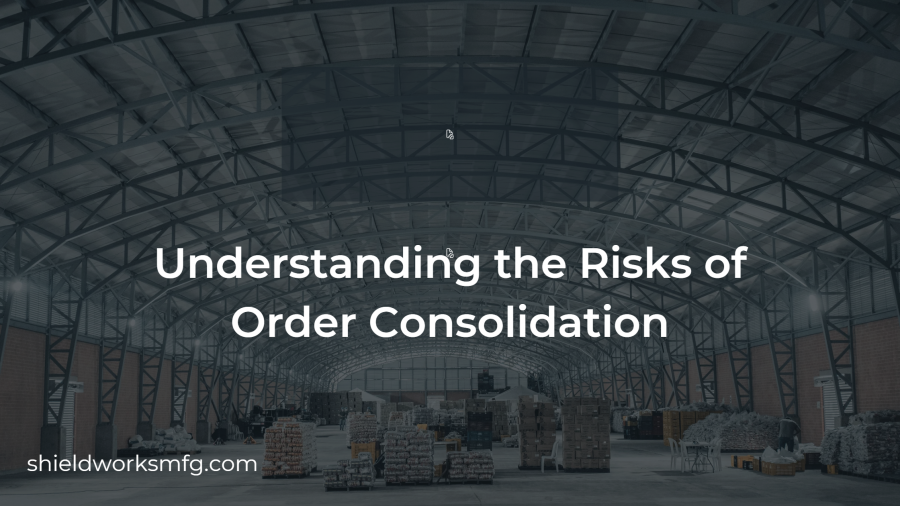
In today’s fast-paced business landscape, order consolidation has become a popular strategy for streamlining supply chain operations and optimizing costs. By combining multiple orders into a single shipment, companies can minimize transportation expenses, reduce inventory holding costs, and enhance overall efficiency. However, it is crucial to be aware of the potential risks associated with order consolidation. This article aims to shed light on these risks, their impact on businesses, and provide practical solutions for mitigating them effectively.
Inventory Management Challenges
One of the primary risks associated with order consolidation lies in inventory management. When multiple orders are consolidated, it becomes essential to manage inventory levels accurately to meet the varying demand of individual customers. Without proper control, there is a higher likelihood of stockouts or overstocking, leading to dissatisfied customers or unnecessary carrying costs. Implementing robust inventory management systems and leveraging advanced forecasting techniques can help strike the right balance and minimize these risks.
Increased Lead Times
Order consolidation often involves the synchronization of different orders from various locations, suppliers, or customers. This synchronization process can increase lead times, resulting in delayed deliveries and potential customer dissatisfaction. It is vital for businesses to closely monitor lead times and establish clear communication channels with all stakeholders involved in the consolidation process. By improving coordination and employing real-time tracking solutions, companies can minimize the impact of increased lead times on customer satisfaction.
Quality Control Issues
Consolidating orders can sometimes introduce quality control challenges. With multiple orders combined into a single shipment, there is a risk of overlooking or missing defects, especially when the individual orders have varying quality standards. To mitigate this risk, businesses should implement stringent quality control processes at various stages of the consolidation process. Conducting thorough inspections, implementing quality checkpoints, and establishing effective feedback loops can help maintain consistent product quality and customer satisfaction.
Increased Transportation Risks
While order consolidation offers cost-saving benefits by reducing transportation expenses, it also introduces certain transportation risks. Combining multiple orders into a single shipment increases the value and volume of the cargo, making it an attractive target for theft or damage during transit. To mitigate these risks, businesses should invest in robust security measures, such as GPS tracking systems, tamper-proof packaging, and insurance coverage. Additionally, selecting reliable logistics partners with a proven track record can help ensure the safe and timely delivery of consolidated orders.
Regulatory Compliance Challenges
Order consolidation often involves compliance with various regulations, especially when dealing with international shipments. Failure to comply with these regulations can result in penalties, delays, or even legal issues. To mitigate regulatory compliance challenges, companies should stay updated with the latest rules and requirements in the relevant jurisdictions. Establishing strong relationships with customs brokers, conducting regular audits, and maintaining accurate documentation can help ensure smooth order consolidation while adhering to legal and regulatory obligations.
Customer Expectations and Communication
Consolidating orders may impact customer expectations and communication. Customers accustomed to receiving individual shipments may be surprised or disappointed when their orders are combined. To manage customer expectations effectively, businesses should proactively communicate the benefits of order consolidation, such as reduced costs and enhanced sustainability. Additionally, providing accurate tracking information, timely updates, and exceptional customer service can help maintain transparency and build trust with customers.
Order consolidation can be a valuable strategy for optimizing supply chain operations and reducing costs. However, it is crucial to understand the associated risks and implement appropriate measures to mitigate them effectively.
Striking a balance between cost-saving measures and potential drawbacks is essential to achieve a streamlined and efficient supply chain while ensuring customer satisfaction and long-term success in today’s competitive business environment.
If you are new to this business with a need for order consolidation partnerships, feel free to contact Shield Works!
Streamlining OEM Sourcing: Best Recommendations & Tips

When it comes to Original Equipment Manufacturer (OEM) sourcing, efficiency and effectiveness are crucial for businesses. Streamlining the process of finding and selecting OEM suppliers can significantly impact a company’s productivity, cost-savings, and overall success. In this article, we will explore the best recommendations and tips to streamline OEM sourcing, enabling businesses to optimize their supply chain management and achieve their goals.
Understanding OEM Sourcing
Before diving into the recommendations and tips, it’s essential to understand what OEM sourcing entails. OEM sourcing involves partnering with external manufacturers to produce components, parts, or products that will be sold under a company’s brand name. This strategic approach allows businesses to leverage specialized expertise and resources while focusing on their core competencies.
Assessing Your Requirements
To streamline the OEM sourcing process, start by assessing your requirements thoroughly. This step involves understanding your product specifications, quality standards, production volume, budget constraints, and delivery timelines. Consider the following recommendations:
- Conduct a comprehensive product analysis: Define the exact specifications and features required for your product. This analysis will help you communicate your requirements effectively to potential OEM suppliers.
- Determine quality standards: Specify the quality standards that your product must meet. This ensures that your OEM supplier can deliver products that align with your brand’s reputation.
- Evaluate production volume: Assess your anticipated production volume to identify suppliers capable of meeting your demand. This evaluation will help you avoid overcapacity or undercapacity issues.
- Define budget constraints: Determine your budget limitations and negotiate pricing with potential suppliers accordingly. Balancing cost and quality is crucial in selecting the right OEM partner.
- Establish delivery timelines: Set realistic delivery timelines and ensure that your OEM supplier can meet your deadlines consistently.
Conducting Market Research
To streamline OEM sourcing, thorough market research is essential. By exploring various options and assessing potential suppliers, you can make informed decisions. Consider the following tips:
- Identify potential suppliers: Utilize industry directories, online platforms, and trade shows to identify potential OEM suppliers. Look for reputable manufacturers with experience in your industry and the desired product category.
- Evaluate supplier capabilities: Assess the capabilities and strengths of potential suppliers. Consider factors such as production capacity, technology, certifications, quality control processes, and their track record with other clients.
- Request samples and prototypes: Request samples or prototypes from shortlisted suppliers to evaluate their product quality, design, and functionality. This step ensures compatibility with your requirements.
- Check references and reviews: Seek references from other clients who have worked with the shortlisted suppliers. Additionally, check online reviews and ratings to gain insights into their reputation and customer satisfaction.
- Consider geographical proximity: Depending on your requirements, consider the advantages of working with suppliers in close proximity. Proximity can lead to faster communication, reduced shipping costs, and better control over production processes.
Building Strong Partnerships
Once you have identified potential OEM suppliers, building strong partnerships is crucial for long-term success. Follow these recommendations to foster productive relationships:
- Communication and collaboration: Establish open lines of communication with your OEM suppliers. Maintain regular contact to address any concerns, provide feedback, and ensure a shared understanding of expectations.
- Clearly define roles and responsibilities: Clearly outline the roles and responsibilities of both parties involved. This clarity helps prevent misunderstandings and promotes efficient collaboration.
- Establish quality control processes: Work with your OEM suppliers to develop comprehensive quality control processes. Regular audits and inspections can help ensure consistent product quality and adherence to specifications.
- Implement performance metrics: Define key performance indicators (KPIs) to assess your OEM suppliers’ performance. Track metrics such as on-time delivery, defect rates, and customer satisfaction to measure their effectiveness.
- Foster continuous improvement: Encourage your OEM suppliers to invest in innovation and continuous improvement. Collaborate on finding ways to optimize production processes, enhance product quality, and reduce costs.
Streamlining OEM sourcing is a critical step in optimizing your supply chain management. By assessing your requirements, conducting thorough market research, and building strong partnerships, you can streamline the process and achieve improved efficiency, cost-savings, and product quality. Embrace these recommendations and tips to ensure a successful OEM sourcing experience for your business. Remember, effective sourcing can give you a competitive edge in today’s dynamic business landscape.
Working with a manufacturer like Shield Works can help take off a lot of pressure of finding the right supplier too. With 18 years of experience in the industry and an expansive network of 500+ suppliers in Asia, you can always count on their professional service. Contact us now!
How Contract Manufacturing Can Help Streamline Your Production
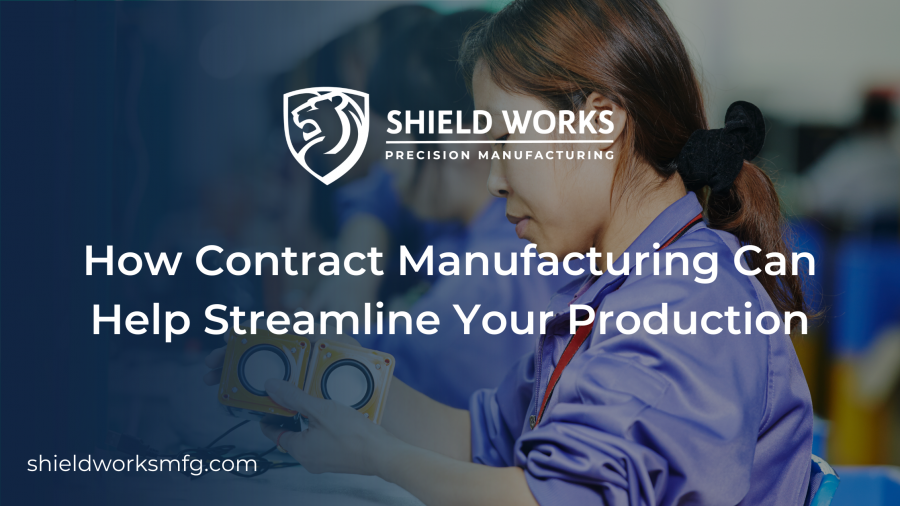
In today’s fast-paced business world, finding effective ways to streamline your production process is crucial to stay ahead of the competition. One strategy that can significantly boost your efficiency and productivity is contract manufacturing. Now, you might be wondering, “What exactly is contract manufacturing, and how can it benefit my business?” Well, my friend, you’ve come to the right place. In this article, we’ll dive deep into the world of contract manufacturing and explore how it can help take your production to new heights.
Understanding Contract Manufacturing: The Basics
Let’s start with the basics. Contract manufacturing, also known as outsourcing or third-party manufacturing, is a business arrangement where a company hires another company, typically a specialized manufacturer, to produce components, products, or complete assemblies on their behalf. In simpler terms, it’s like having a trusted partner who handles the manufacturing process while you focus on other critical aspects of your business.
The Benefits of Contract Manufacturing
Now that we’ve covered the definition, let’s explore the various benefits that contract manufacturing brings to the table.
1. Cost Savings and Improved Efficiency
When you choose contract manufacturing, you can reap significant cost savings. Instead of investing heavily in establishing your own production facilities, hiring specialized staff, and purchasing expensive equipment, you can leverage the existing infrastructure and expertise of the contract manufacturer. This means you can reduce your upfront capital expenditure and operational costs, allowing you to allocate your resources more efficiently.
2. Access to Specialized Skills and Technologies
One of the key advantages of contract manufacturing is gaining access to specialized skills and technologies that may not be available in-house. Contract manufacturers are experts in their respective fields, equipped with the knowledge and experience to handle complex production processes. By partnering with them, you can tap into their specialized capabilities, leverage their cutting-edge technologies, and ensure that your products are manufactured to the highest standards of quality.
3. Flexibility and Scalability
In today’s ever-changing market landscape, flexibility and scalability are paramount. Contract manufacturing offers the flexibility to adjust your production volume based on demand fluctuations without incurring excessive costs. Whether you need to scale up during peak seasons or scale down during slower periods, your contract manufacturer can adapt to your needs, providing you with the agility required to stay competitive.
4. Focus on Core Competencies
By entrusting your manufacturing operations to a contract manufacturer, you can redirect your focus and resources towards your core competencies. Instead of spreading yourself thin by trying to handle every aspect of production, you can concentrate on product development, marketing, and building stronger relationships with your customers. This allows you to play to your strengths and differentiate yourself in the market.
5. Quality Assurance and Regulatory Compliance
Maintaining consistent product quality and complying with industry regulations are vital for any business. Contract manufacturers have established quality control processes in place to ensure that every product meets the specified standards. Moreover, they stay updated with the latest regulatory requirements, saving you the time and effort of navigating complex compliance frameworks. This gives you peace of mind, knowing that your products are in capable hands.
Finding the Right Contract Manufacturer
Now that you understand the advantages of contract manufacturing, it’s important to know how to choose the right partner for your business. Here are a few key factors to consider:
Experience and Expertise
Look for a contract manufacturer with a proven track record in your industry and the relevant expertise to handle your specific manufacturing needs.
Quality Management
Assess their quality management systems and certifications to ensure they adhere to stringent quality standards.
Production Capacity
Evaluate their production capacity to ensure they can meet your volume requirements, both now and in the future.
Communication and Collaboration
Strong communication and collaboration are essential for a successful partnership. Choose a contract manufacturer that values open and transparent communication.
Cost Structure
While cost shouldn’t be the sole determining factor, it’s important to have a clear understanding of the contract manufacturer’s pricing structure to ensure it aligns with your budget and business goals.
Taking Your Production to New Heights
In conclusion, contract manufacturing can be a game-changer for your business. It offers numerous benefits, including cost savings, access to specialized skills, flexibility, and the ability to focus on your core competencies. By finding the right contract manufacturer who understands your unique requirements, you can streamline your production process and position yourself for growth and success in today’s competitive market.
So, my friend, if you’re ready to unlock the full potential of your production capabilities, it’s time to consider contract manufacturing. Embrace the power of collaboration, leverage the expertise of trusted partners, and watch your production efficiency soar. Shield Works can provide you just that with their world-class facility and vast supplier network. Remember, success favors those who adapt and evolve with the changing times. Stay ahead of the curve and contact us today!
